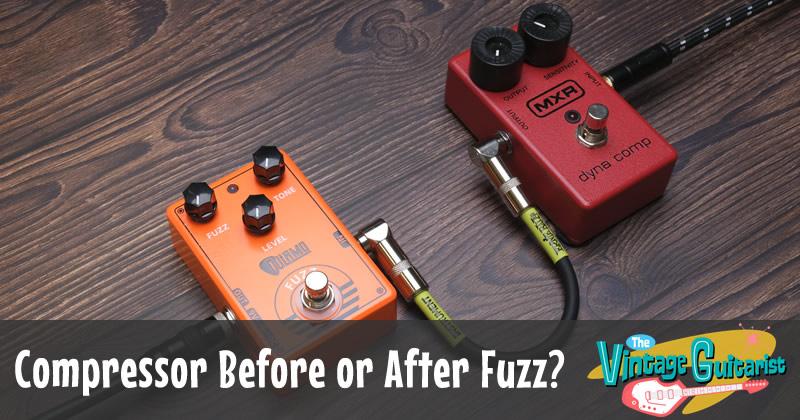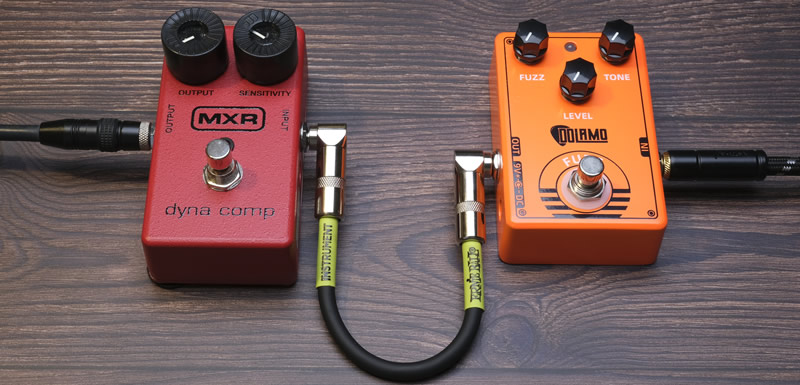So, you’ve got yourself a fuzz pedal and a compressor pedal. You know what each one does separately, but how do you use them together? Specifically, which one should come first in your signal chain – the fuzz or the compressor?

It’s a common question among guitarists, and there’s no one right answer. Some players swear by putting their compressor before their fuzz to even out the dynamics of their playing, while others prefer to put the fuzz first for maximum raunchiness. In this article, we’ll take a closer look at each approach and help you decide which is right for your rig.
A Brief Overview of Compressor Pedals
Guitar compressor pedals provide dynamic control for guitarists. They even out volume levels, enhance sustain, and maintain a consistent tone. With controls for attack, release, ratio, and threshold, they allow musicians to shape their sound. Compressors are essential in studio recording and live performances, helping guitars sit well in mixes and adding polish to solos. They are valuable tools for achieving a professional and balanced tone.
A Brief Overview of Fuzz Pedals
Fuzz pedals add a gritty and distorted tone to a guitar’s sound. They clip the signal, creating a warm and harmonically rich fuzz effect. With controls for gain, tone, and additional features like octave effects, fuzz pedals offer versatility for various musical styles. They are popular for adding character and intensity to solos, chords, and riffs, making them a valuable tool in both studio recording and live performances.
Demystifying the Guitar Pedal Chain
First things first, let’s talk about the signal chain. The signal chain is the order in which your effects pedals are connected, and it plays a significant role in shaping your overall tone. Alongside the fuzz and compressor, you might have distortion pedals, delay pedals, modulation pedals, and maybe even a noise gate thrown into the mix. Each pedal in your chain interacts with the others, creating a unique sonic palette that is entirely yours.
A typical pedal order might look something like this:
- Tuner
- Filter/Envelope
- Compression
- Drive: Overdrive / Distortion / Fuzz
- Modulation Effects: Chorus / Flanger / Phaser / Tremolo
- Delay
- Reverb
- EQ
- Volume Pedal / Boost
- Noise Gate
Compression Before Your Fuzz Pedal
One primary reason for placing the compressor before the fuzz pedal is to ensure that the compressed signal feeds into the fuzz circuitry. Fuzz pedals thrive on a high input signal, often referred to as “hot” or “driving” input.

The compressed signal can provide a consistent and robust foundation for the fuzz to work with, enhancing the sustain and saturation characteristics of the fuzz tone. This combination can result in a smoother and more controlled fuzz sound, allowing the nuances of your playing to shine through.
Furthermore, when the compressor precedes the fuzz pedal, it helps to tame any excessive peaks or spikes in your guitar’s signal. Fuzz pedals are notorious for amplifying and exaggerating the dynamics of your playing.
Placing a compressor before the fuzz can reduce the chances of the fuzz pedal reacting unpredictably to sudden changes in volume, resulting in a more balanced and controlled fuzz tone.
Advantages and Disadvantages of Placing Compressor Before Fuzz
While there are compelling arguments for placing a compressor before a fuzz pedal, it’s important to consider both the advantages and disadvantages of this pedal order.
Advantages
- Enhanced sustain: The compressor before the fuzz can increase the sustain of your guitar’s notes, allowing them to ring out longer and providing a more prominent and expressive tone.
- Smoother dynamics: By taming the peaks and valleys in your guitar’s signal, the compressor can create a more consistent and controlled dynamic response when combined with the fuzz pedal.
- Nuanced playing: The compressed signal can preserve the subtleties and intricacies of your playing, allowing for greater expression and articulation within the fuzz tone.
Disadvantages
- Reduced fuzz dynamics: Placing a compressor before the fuzz pedal may compress the natural dynamics and responsiveness of the fuzz, potentially limiting the range of tones and textures it can produce.
- Loss of fuzz character: Some guitarists argue that compressing the signal before it reaches the fuzz can soften the unique and raw characteristics that make fuzz pedals desirable, potentially sacrificing some of the pedal’s distinctive qualities.
Compression After Your Fuzz Pedal
One key reason for placing the compressor after the fuzz pedal is to retain the dynamics and tonal character produced by the fuzz.

Fuzz pedals generate a distinctive and often unruly saturation, adding harmonics and compression of their own. Placing the compressor after the fuzz allows the fuzz’s unique texture and dynamics to remain intact, while the compressor smooths out the overall output, enhancing sustain and control without compromising the fuzz’s original sound.
Additionally, by compressing the already distorted signal produced by the fuzz pedal, you can achieve increased sustain and a more pronounced sustain tail. The compressor can help preserve the sustain and allow your notes to ring out longer, adding depth and richness to your sound. This combination of fuzz-driven saturation and compressed sustain can result in a captivating and expressive tone, particularly for solos and sustained passages.
Advantages and Disadvantages of Placing Compressor After Fuzz
While there are valid arguments for placing a compressor after a fuzz pedal, it’s crucial to consider the advantages and disadvantages of this pedal order.
Advantages
- Retained fuzz dynamics: Placing the compressor after the fuzz pedal allows the fuzz’s natural dynamics and tonal character to be preserved, maintaining the raw and untamed qualities that make fuzz pedals desirable.
- Increased sustain: The combination of a compressed signal and the already saturated fuzz tone can result in extended sustain, allowing your notes to sustain and decay in a pleasing and musical way.
- Unique tonal textures: The compression applied to the fuzzed signal can create interesting and nuanced tonal textures, adding depth and complexity to your sound.
Disadvantages
- Reduced control over dynamics: Placing the compressor after the fuzz pedal may limit the compressor’s control over the dynamic range of your guitar’s signal, as the fuzz pedal has already introduced its own compression and saturation.
- Possible noise amplification: As the compressed signal includes the inherent noise and artifacts produced by the fuzz pedal, the compressor placed after the fuzz may amplify these elements, potentially resulting in unwanted noise or interference.
Conclusion
When it comes to finding the perfect guitar tone, where you position your guitar pedals can make a significant difference. The age-old question of whether to place the compressor before or after the fuzz pedal doesn’t have a definitive answer. There is no universal solution that all guitarists prefer. It ultimately depends on your personal preference and the specific sound you want to achieve.
Look, while I know it might seem like a cop-out but you need to experiment and decide what is best for YOUR sound. You’ve read about the principles but now you need to try it and see which you actually prefer for your playing style.
While it may be tempting to look for the “Industry standard” way of doing things, the reality of chaining effects pedals is there is no wrong way of doing anything.
So, grab your guitar, compressor, and fuzz pedal, and start playing.
